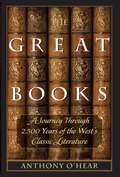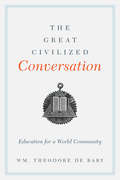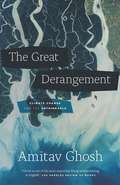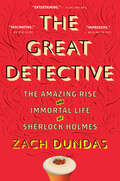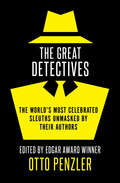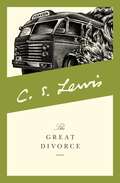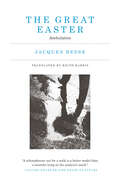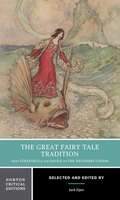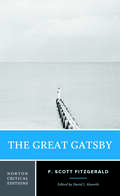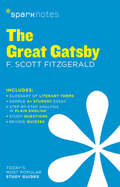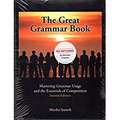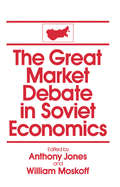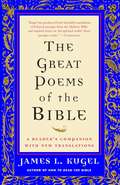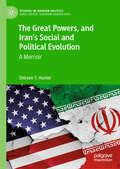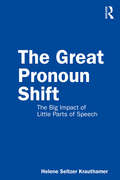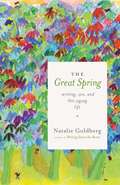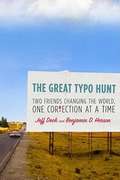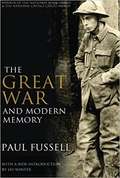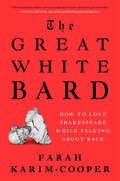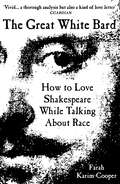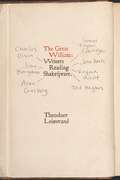- Table View
- List View
The Great Books: A Journey through 2,500 Years of the West's Classic Literature
by Anthony O'Hear"An illuminating, learned, well-written, and entertaining survey of the giants of world literature. Busy people, and especially the young, will be grateful for this useful and concise introduction." —Paul Johnson Not simply a grand work of reference, The Great Books is a captivating journey through two-and-a-half millennia of the great Western tradition. The eminent British philosopher Anthony O'Hear is our capable tour guide, taking readers on an exhilarating tour through 2,500 years of books as powerful, thrilling, erotic, politically astute, and awe-inspiring as any modern bestseller. The Great Books is a fascinating narrative that encompasses history, myth, art, music, theater, and more. O'Hear sweeps us along from Homer's Iliad to Goethe's Faust, covering much ground in between. In Homer's poems of epic struggle we discover not only the fascination and pleasure we can derive, but also why these works became the fountainhead of Western literature. From Greek tragedy we feel the power of the ancient myths, while from Plato's Death of Socrates we see what may have killed off the tragic spirit. In Virgil's Aeneid we ponder the close connections to—and puzzling contrasts with—Homer; in Dante's terrifying and sublime Divine Comedy we encounter Virgil once again, this time as mentor and guide through Hell; and in Milton's phantasmagoric Paradise Lost we find the Christian story given epic shape and power. And of course, in Shakespeare we experience the great dramatist's particular and incomparable genius. There is much more beyond—from Ovid and Augustine to Chaucer and Cervantes, Pascal and Racine. The Great Books is a spirited and enlightening guide to the great works of the Western tradition, shot through with a love of literature and the author's deeply held belief in its power to enrich and enliven everyone's world.
The Great Civilized Conversation: Education for a World Community (Asia Perspectives: History, Society, And Culture (coup) Ser.)
by Wm. Theodore BaryHaving spent decades teaching and researching the humanities, Wm. Theodore de Bary is well positioned to speak on its merits and reform. Believing a classical liberal education is more necessary than ever, he outlines in these essays a plan to update existing core curricula by incorporating classics from both Eastern and Western traditions, thereby bringing the philosophy and moral values of Asian civilizations to American students and vice versa.The author establishes a concrete link between teaching the classics of world civilizations and furthering global humanism. Selecting texts that share many of the same values and educational purposes, he joins Islamic, Indian, Chinese, Japanese, and Western sources into a revised curriculum that privileges humanity and civility. He also explores the tradition of education in China and its reflection of Confucian and Neo-Confucian beliefs. He reflects on history's great scholar-teachers and what their methods can teach us today, and he dedicates three essays to the power of The Analects of Confucius, The Tale of Genji, and The Pillow Book of Sei Shonagon in the classroom.
The Great Derangement: Climate Change and the Unthinkable (Berlin Family Lectures)
by Amitav GhoshAre we deranged? The acclaimed Indian novelist Amitav Ghosh argues that future generations may well think so. How else to explain our imaginative failure in the face of global warming? In his first major book of nonfiction since In an Antique Land, Ghosh examines our inability--at the level of literature, history, and politics--to grasp the scale and violence of climate change. The extreme nature of today's climate events, Ghosh asserts, make them peculiarly resistant to contemporary modes of thinking and imagining. This is particularly true of serious literary fiction: hundred-year storms and freakish tornadoes simply feel too improbable for the novel; they are automatically consigned to other genres. In the writing of history, too, the climate crisis has sometimes led to gross simplifications; Ghosh shows that the history of the carbon economy is a tangled global story with many contradictory and counterintuitive elements. Ghosh ends by suggesting that politics, much like literature, has become a matter of personal moral reckoning rather than an arena of collective action. But to limit fiction and politics to individual moral adventure comes at a great cost. The climate crisis asks us to imagine other forms of human existence--a task to which fiction, Ghosh argues, is the best suited of all cultural forms. His book serves as a great writer's summons to confront the most urgent task of our time.
The Great Detective: The Amazing Rise and Immortal Life of Sherlock Holmes
by Zach DundasA wickedly smart and rollicking journey through the birth, life, and afterlives of popular culture's most beloved sleuthToday he is the inspiration for fiction adaptations, blockbuster movies, hit television shows, raucous Twitter banter, and thriving subcultures. More than a century after Sherlock Holmes first capered into our world, what is it about Arthur Conan Doyle&’s peculiar creation that continues to fascinate us? Journalist and lifelong Sherlock fan Zach Dundas set out to find the answer. The result is The Great Detective: a history of an idea, a biography of someone who never lived, a tour of the borderland between reality and fiction, and a joyful romp through the world Conan Doyle bequeathed us. Through sparkling new readings of the original stories, Dundas unearths the inspirations behind Holmes and his indispensable companion, Dr. John Watson, and reveals how Conan Doyle's tales laid the groundwork for an infinitely remixable myth, kept alive over the decades by writers, actors, and readers. This investigation leads Dundas on travels into the heart of the Holmesian universe. The Great Detective transports us from New York City's Fifth Avenue and the boozy annual gathering of one of the world's oldest and most exclusive Sherlock Holmes fan societies; to a freezing Devon heath out of The Hound of the Baskervilles; to sunny Pasadena, where Dundas chats with the creators of the smash BBC series Sherlock and even finagles a cameo appearance by Benedict Cumberbatch himself. Along the way, Dundas discovers and celebrates the ingredients that have made Holmes go viral — then, now, and as long as the game&’s afoot.
The Great Detectives: The World's Most Celebrated Sleuths Unmasked by Their Authors
by Otto PenzlerThe origins of literature&’s finest crime fighters, told by their creators themselves Their names ring out like gunshots in the dark of a back alley, crime fighters of a lost era whose heroic deeds will never be forgotten. They are men like Lew Archer, Pierre Chambrun, Flash Casey, and the Shadow. They are women like Mrs. North and the immortal Nancy Drew. These are detectives, and they are some of the only true heroes the twentieth century ever knew. In this classic volume, Otto Penzler presents essays written by the authors who created these famous characters. We learn how Ed McBain killed—and resurrected—the hero of the 87th Precinct, how international agent Quiller wrote his will, and how Dick Tracy first announced that &“crime does not pay.&” Some of these heroes may be more famous than others, but there is not one whom you wouldn&’t like on your side in a courtroom, a shootout, or an old-fashioned barroom brawl.
The Great Divorce (C. S. Lewis Signature Classic Ser.)
by C. S. LewisC. S. Lewis takes us on a profound journey through both heaven and hell in this engaging allegorical tale. Using his extraordinary descriptive powers, Lewis introduces us to supernatural beings who will change the way we think about good and evil.
The Great Easter: Ambulation
by Jacques BesseA hallucinating, insomniac, and increasingly fragile flaneur wanders the streets of Paris over the long Easter weekend of 1960.Paris, Easter weekend 1960. The French composer Jacques Besse sets out on a marathon stroll through the city that begins on Good Friday, when he leaves his brother&’s house on rue de Turbigo, and ends on Easter Monday, when, having declared himself Mars, the god of war, to mystified restaurant-goers, he ambles back toward Saint-Germain-des-Prés. The Great Easter—a memoir in the form of a novella, or perhaps a novella in the form of a memoir—is the first-person account of a hallucinating, insomniac, and increasingly fragile flaneur&’s unending ambulation. The Great Easter was first published in French in 1969 and became famous a few years later when in their milestone work Anti-Oedipus Gilles Deleuze and Félix Guattari referred to Besse&’s walk as the quintessential &“double stroll of the schizo.&” (Besse was a patient at Guattari&’s psychiatric clinic La Borde.) Besse&’s stroll purées past and present, real and not-real: a rendezvous with a prostitute intersects with Sergei Eisenstein and his entourage, a bellowed song about the sea is overwhelmed by &“memories&” of the 1830 July Revolution, and the entire universe gathers itself up into a bubble above Gare d&’Austerlitz. He is seized by anxiety, released by joy; he announces his cosmic celebrity via a huge (imaginary) television while freezing in the night and calling out for bread. A cult favorite in France, The Great Easter is an engrossing, surreal road movie of a book.
The Great Fairy Tale Tradition: From Straparola And Basile To The Brothers Grimm
by Jack ZipesThe tales―116 in all―are thematically grouped. Each grouping is introduced and annotated by Jack Zipes, the genre’s reigning expert. Twenty illustrations accompany the texts. "Criticism" includes seven important assessments of different aspects of the fairy tale tradition, written by W. G. Waters, Benedetto Croce, Lewis Seifert, Patricia Hannon, Harry Velten, Siegfried Neumann, and Jack Zipes. Brief biographies of the storytellers and a Selected Bibliography are included.
The Great Gatsby (Norton Critical Editions #0)
by F. Scott Fitzgerald“This superb volume offers a rich cultural fabric that greatly deepens our understanding of The Great Gatsby. Illuminating short stories by Fitzgerald, his correspondence, and his literary inspirations are all featured here. An indispensable edition.” —Wai Chee Dimock, Yale University This Norton Critical Edition includes: The 1925 first American edition text of the novel. A full introduction, a note on the text, and explanatory annotations by David J. Alworth. An unusually rich selection of contextual materials, including Fitzgerald’s sources for his greatest novel, excerpts from his ledger and notebooks, three of his related short stories, twenty-two carefully chosen letters concerning The Great Gatsby, and eight selections—four of them by Fitzgerald—on the Jazz Age and American Modernism. A wide range of critical assessments, covering initial reviews and reactions, Fitzgerald’s revival, and reconsiderations and recent readings. A chronology and selected bibliography. About the Series Read by more than 12 million students over fifty-five years, Norton Critical Editions set the standard for apparatus that is right for undergraduate readers. The three-part format—annotated text, contexts, and criticism—helps students to better understand, analyze, and appreciate the literature, while opening a wide range of teaching possibilities for instructors. Whether in print or in digital format, Norton Critical Editions provide all the resources students need.
The Great Gatsby SparkNotes Literature Guide (SparkNotes Literature Guide Series #30)
by SparkNotesThe Great Gatsby SparkNotes Literature Guide by F. Scott Fitzgerald Making the reading experience fun! When a paper is due, and dreaded exams loom, here's the lit-crit help students need to succeed! SparkNotes Literature Guides make studying smarter, better, and faster. They provide chapter-by-chapter analysis; explanations of key themes, motifs, and symbols; a review quiz; and essay topics. Lively and accessible, SparkNotes is perfect for late-night studying and paper writing. Includes:An A+ Essay—an actual literary essay written about the Spark-ed book—to show students how a paper should be written.16 pages devoted to writing a literary essay including: a glossary of literary termsStep-by-step tutoring on how to write a literary essayA feature on how not to plagiarize
The Great Grammar Book
by Marsha SramekGrammar books typically suffer from the "ugh" factor; they're a necessary tool for writing, but no one actually enjoys reading them. Well, Marsha Sramek's The Great Grammar Book: Mastering Grammar Usage and the Essentials of Composition is not typical. She uses fun facts, news article excerpts, and goofy trivia to demonstrate the principles of grammar. Plus, she vaporizes all that stuffy hot air espoused by the grammar police.
The Great Grammar Book: Mastering Grammar Usage and the Essentials of Composition, Second Edition
by Marsha Sramek<P>This book is fun to read, with fascinating, arcane information that could make you a trivia champion.<P> The Great Grammar Book uses and explains only those grammatical terms which are necessary to avoid mistakes or improve writing skills.<P> Whether you are a student or professional, this book will help you write more effectively and clearly. <P>This book focuses on the most frequent errors in English and how to correct these errors. <P>There are enough practice sentences and exercises to overcome long-standing bad grammatical habits.
The Great Market Debate in Soviet Economics: An Anthology
by David M Jones William MoskoffThe most agonizing and protracted of all the Soviet reform debates has been the debate over economic reform. This anthology of essays and roundtables from party, professional and literary journals surveys the key issues in the market debate.
The Great Poems of the Bible: A Reader's Companion with New Translations
by James L. KugelFrom the Psalms to the Prophets, from job to Ecclesiastes, much of the Bible is written in poetry. The poems of the Bible include some of its best known and most beloved passages: "The Lord is my shepherd," "Let justice roll down like waters," "By the rivers of Babylon," "Remember your Creator," "Arise, shine, for thy light is come!" These poems live in the hearts of those who are familiar with the Bible and offer rich rewards to anyone who is approaching the world's greatest book for the first time.In The Great Poems of the Bible, Harvard scholar James Kugel presents original translations of the most beautiful and important poems of the Scripture. Taken together, these poems represent the very essence of the Hebrew Bible. Reading them one after another is like taking a guided tour through Scripture, meeting firsthand some of its most important teachings and opening the way to an understanding of the Bible as a whole.Each poem is accompanied by an eloquent and accessible explanation of the poem's language, and a reflection on its meaning. These learned, compact essays introduce readers to the broader spiritual world of ancient Israel. What did people in biblical times believe about God? Where is a person's soul located and what does it do? Is there an afterlife? How does one come to "know" God? Why wasn't Eve meant to be Adam's "helpmate" (Kugel shows how this was just a translator's slip-up), and what does the Bible have to say about the role of women?Kugel's sparkling translations of the poems, together with the fascinating insights that accompany them, distill the very best that the Bible and modern scholarship have to offer. Kugel brings new life to some of history's greatest poems, and offers a new look at a Bible we thought we already knew. Here, in one volume, is a "Bible's bible" that belongs in every home.
The Great Powers, and Iran's Social and Political Evolution: A Memoir (Studies in Iranian Politics)
by Shireen T. HunterThis book is a personal narrative chronicling the life and experiences of Shireen Hunter, an Iranian woman who came of age during a transformative era in Iran’s history. It begins by spanning the tumultuous aftermath of World War II to the pivotal 1979 revolution, providing a poignant account of the profound impact of these historical events on the author’s life. The book delves into the multifaceted consequences of the reformist period that began in the 1960s. They enabled Shireen to enter the diplomatic service, but also cast a shadow of adversity over her family. Ultimately, the reforms contributed to internal divisions that ignited the 1979 revolution. The book then explores Shireen’s immigrant experience in the USA, where she assumed the role of an “ethnic expert” in the volatile arena of Middle East politics. It candidly recounts challenges she faced in maintaining intellectual integrity while earning a livelihood, highlighting the precariousness of being on the right side of controversial issues. The book does not offer definitive solutions to specific problems. Yet it resonates with contemporary international security and developmental challenges and offers insights that remain relevant in today’s complex global landscape. With its multifaceted narrative encompassing Iran’s social and political history, women’s studies, immigrant experiences, and a personal perspective on critical junctures in U.S.-Iranian relations, this book appeals to a diverse readership. It provides a unique window into “lived” experiences and analytical reflections of an individual who has traversed the intersections of history, identity, and diplomacy, offering invaluable insights into both past and present.
The Great Pronoun Shift: The Big Impact of Little Parts of Speech
by Helene Seltzer KrauthamerThis book is a holistic exploration of personal pronouns in English and their development. In conversational prose and drawing on linguistic and psychological research, Helene Seltzer Krauthamer gives an overview of what pronouns are, why they are problematic, what they reveal about us, how they can be used effectively, where they came from, and where they are going. Assuming no specialized knowledge and with helpful real-world exercises at the end of each chapter, the book aids growth and inspires thought in students and other readers, spelling out the implications of these changes for teachers, writers, and all who write or speak in English.
The Great Spring
by Natalie GoldbergFrom beloved writing teacher and author of the best-selling Writing Down the Bones: a treasury of personal stories reflecting a life filled with journeys--inner and outer--zigzagging around the world and home again. Here, Natalie Goldberg, "a writer both energized and enlightened" (Julia Cameron), shares those vivid moments that have wakened her to new ways of being. We follow alongside her mapless meanderings in the New Mexican desert and her pilgrimages to Bob Dylan's birthplace and to Larry McMurtry's dusty Texas ghost town of rare books. We feel her deep hunger while she sits zazen in a monastery in Japan, and her profound loss when she hears of the passing of a dear friend while teaching in the French countryside. Through it all, she remains grounded in a life informed by two constants: the practices of writing and of Zen. With humor and insight, Natalie encircles around the essential questions these paths compel her toward:Where does this life lead? Who are we? This is a book to be relished one awakening at a time. Each story is a reminder that no matter how hard the situation or desolate you may feel, spring will come again, breaking through a cold winter, bringing early yellow forsythia flowers. And the Great Spring of enlightenment--that sudden rush of acceptance, pain cracking open, obstructions shattering--will also burst forth. .
The Great Spring: Writing, Zen, and This Zigzag Life
by Natalie GoldbergFrom beloved writing teacher and author of the best-selling Writing Down the Bones: a treasury of personal stories reflecting a life filled with journeys—inner and outer—zigzagging around the world and home again.Here, Natalie Goldberg, "a writer both energized and enlightened" (Julia Cameron), shares those vivid moments that have wakened her to new ways of being. We follow alongside her mapless meanderings in the New Mexican desert and her pilgrimages to Bob Dylan's birthplace and to Larry McMurtry's dusty Texas ghost town of rare books. We feel her deep hunger while she sits zazen in a monastery in Japan, and her profound loss when she hears of the passing of a dear friend while teaching in the French countryside.Through it all, she remains grounded in a life informed by two constants: the practices of writing and of Zen. With humor and insight, Natalie encircles around the essential questions these paths compel her toward: Where does this life lead? Who are we?This is a book to be relished one awakening at a time. Each story is a reminder that no matter how hard the situation or desolate you may feel, spring will come again, breaking through a cold winter, bringing early yellow forsythia flowers. And the Great Spring of enlightenment—that sudden rush of acceptance, pain cracking open, obstructions shattering—will also burst forth.
The Great Typo Hunt
by Jeff Deck Benjamin D. HersonThe signs of the times are missing apostrophes. The world needed a hero, but how would an editor with no off-switch answer the call? For Jeff Deck, the writing was literally on the wall: "NO TRESSPASSING." In that moment, his greater purpose became clear. Dark hordes of typos had descended upon civilization... and only he could wield the marker to defeat them. Recruiting his friend Benjamin and other valiant companions, he created the Typo Eradication Advancement League (TEAL). Armed with markers, chalk, and correction fluid, they circumnavigated America, righting the glaring errors displayed in grocery stores, museums, malls, restaurants, mini-golf courses, beaches, and even a national park. Jeff and Benjamin championed the cause of clear communication, blogging about their adventures transforming horor into horror, it's into its, and coconunut into coconut. But at the Grand Canyon, they took one correction too far: fixing the bad grammar in a fake Native American watchtower. The government charged them with defacing federal property and summoned them to court--with a typo-ridden complaint that claimed that they had violated "criminal statues." Now the press turned these paragons of punctuation into "grammar vigilantes," airing errors about their errant errand.. The radiant dream of TEAL would not fade, though. Beneath all those misspelled words and mislaid apostrophes, Jeff and Benjamin unearthed deeper dilemmas about education, race, history, and how we communicate. Ultimately their typo-hunting journey tells a larger story not just of proper punctuation but of the power of language and literacy--and the importance of always taking a second look.From the Hardcover edition.
The Great Typo Hunt: Two Friends Changing the World, One Correction at a Time
by Jeff Deck Benjamin D. HersonThe signs of the times are missing apostrophes. The world needed a hero, but how would an editor with no off-switch answer the call? For Jeff Deck, the writing was literally on the wall: "NO TRESSPASSING. " In that moment, his greater purpose became clear. Dark hordes of typos had descended upon civilization... and only he could wield the marker to defeat them. Recruiting his friend Benjamin and other valiant companions, he created the Typo Eradication Advancement League (TEAL). Armed with markers, chalk, and correction fluid, they circumnavigated America, righting the glaring errors displayed in grocery stores, museums, malls, restaurants, mini-golf courses, beaches, and even a national park. Jeff and Benjamin championed the cause of clear communication, blogging about their adventures transforming horor into horror,it's into its, and coconunut into coconut. But at the Grand Canyon, they took one correction too far: fixing the bad grammar in a fake Native American watchtower. The government charged them with defacing federal property and summoned them to court-with a typo-ridden complaint that claimed that they had violated "criminal statues." Now the press turned these paragons of punctuation into "grammar vigilantes," airing errors about their errant errand. The radiant dream of TEAL would not fade, though. Beneath all those misspelled words and mislaid apostrophes, Jeff and Benjamin unearthed deeper dilemmas about education, race, history, and how we communicate. Ultimately their typo-hunting journey tells a larger story not just of proper punctuation but of the power of language and literacy-and the importance of always taking a second look.
The Great War (Great Minds Wit & Wisdom, Grade 8 #Module 2)
by Ann Brigham Lauren Chapalee Lorraine GriffithNIMAC-sourced textbook
The Great War and Modern Memory
by Paul FussellFussell writes: This book is about the British experience on the Western Front from 1914 to 1918 and some of the literary means by which it has been remembered, conventionalized, and mythologized. It is also about the literary dimensions of the trench experience itself. Indeed, if the book had a subtitle, it would be something like "An Inquiry into the Curious Literariness of Real Life." <P><P> Winner of the National Book Award
The Great White Bard: How to Love Shakespeare While Talking About Race
by Farah Karim-CooperAs we witness monuments of white Western history fall, many are asking how is Shakespeare still relevant? Professor Farah Karim-Cooper has dedicated her career to the Bard, which is why she wants to take the playwright down from his pedestal to unveil a Shakespeare for the twenty-first century. If we persist in reading Shakespeare as representative of only one group, as the very pinnacle of the white Western canon, then he will truly be in peril. Combining piercing analysis of race, gender and otherness in famous plays from Antony and Cleopatra to The Tempest with a radical reappraisal of Elizabethan London, The Great White Bard asks us neither to idealize nor bury Shakespeare but instead to look him in the eye and reckon with the discomforts of his plays, playhouses and society. In inviting new perspectives and interpretations, we may yet prolong and enrich his extraordinary legacy.
The Great White Bard: How to Love Shakespeare While Talking About Race
by Farah Karim-CooperSHAKESPEARE: increasingly irrelevant or lone literary genius of the Western canon?'Powerful and illuminating' James Shapiro, author of 1599: A Year in the Life of William Shakespeare, winner of the Baillie Gifford 'Winner of Winners' 2023 Professor Farah Karim-Cooper grew up loving the Bard, perhaps because Romeo and Juliet felt Pakistani to her. But why was being white as a &‘snowy dove&’ essential to Juliet&’s beauty? Combining piercing analysis of race, gender and otherness in beloved plays from Othello to The Tempest with a radical reappraisal of Elizabethan London, The Great White Bard entreats us neither to idealise nor to fossilise Shakespeare but instead to look him in the eye and reckon with the discomforts of his plays, playhouses and society. If we persist in reading Shakespeare as representative of only one group, as the very pinnacle of the white Western canon, then he will truly be in peril. But if we dare to bring Shakespeare down from his plinth, we might unveil a playwright for the twenty-first century. We might expand and enrich his extraordinary legacy. We might even fall in love with him all over again. *** A TIME MAGAZINE BOOK OF THE YEAR 2023 'Insightful, passionate, piled with facts and has a warm, infectious love for theatre and Shakespeare running through every chapter.' ADRIAN LESTER, CBE 'Dive in and your whole cultural landscape will be refreshed and reframed... A challenging, riveting read, The Great White Bard reminds us how powerful the stories we tell can be on our lives.' ADJOA ANDOH 'Vivid… a thorough analysis but also a kind of love letter… Karim-Cooper sees Shakespeare as holding a mirror to this society, with his plays interrogating live issues around race, identity and the colonial enterprise… Her arguments come to feel essential and should be absorbed by every theatre director, writer, critic, interested in finding new ways into the work.&’ GUARDIAN 'There are plenty of books on Shakespeare: but this one is different. This is Shakespeare as we&’ve (most of us) never been willing to see him – and the works emerge from the analysis as newly complicit, powerful and yet recuperative.' EMMA SMITH, AUTHOR OF PORTABLE MAGIC
The Great William: Writers Reading Shakespeare
by Theodore LeinwandThe Great William is the first book to explore how seven renowned writers--Samuel Taylor Coleridge, John Keats, Virginia Woolf, Charles Olson, John Berryman, Allen Ginsberg, and Ted Hughes--wrestled with Shakespeare in the very moments when they were reading his work. What emerges is a constellation of remarkable intellectual and emotional encounters. Theodore Leinwand builds impressively detailed accounts of these writers' experiences through their marginalia, lectures, letters, journals, and reading notes. We learn why Woolf associated reading Shakespeare with her brother Thoby, and what Ginsberg meant when referring to the mouth feel of Shakespeare's verse. From Hughes's attempts to find a "skeleton key" to all of Shakespeare's plays to Berryman's tormented efforts to edit King Lear, Leinwand reveals the palpable energy and conviction with which these seven writers engaged with Shakespeare, their moments of utter self-confidence and profound vexation. In uncovering these intense public and private reactions, The Great William connects major writers' hitherto unremarked scenes of reading Shakespeare with our own.
